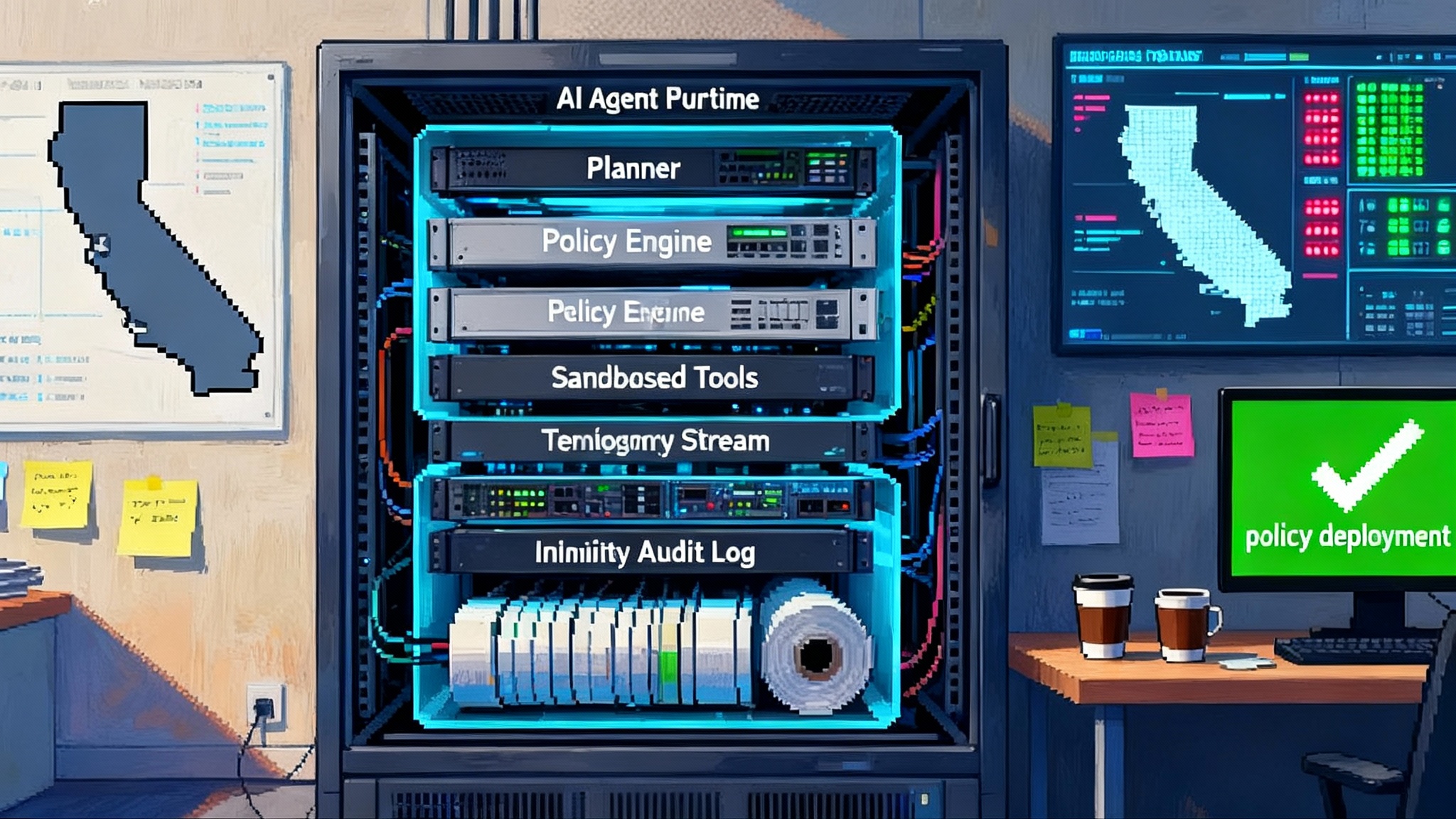When Web Pages Become Workers: The Agentic Browser Era
AI is moving from chat boxes into the browser itself. Opera’s Neon can act on pages, Perplexity made its Comet browser free, and Google is wiring Gemini into Chrome. The page is turning into a capable colleague that gets real work done.
Breaking: the browser just started working for you
A quiet shift turned loud over the past few weeks. On September 30, 2025, Opera launched Neon, a browser that can read a page, click, type, and move through steps on your behalf, with much of the work running locally for privacy and control. The debut was covered widely, including Reuters on Opera Neon launch. Two days later, Perplexity opened its Comet agentic browser to everyone for free, after a summer behind a paywall for higher tiers. And on September 18, 2025, Google began rolling Gemini directly into Chrome for United States users in English, pitching multi step help such as organizing tabs, summarizing pages, and completing routine flows. Google framed it as a major upgrade to Chrome and shared specifics in its announcement, Chrome reimagined with AI.
If you have followed AI as a stream of new models and smarter chat boxes, this moment feels different. It is not about one more benchmark or one more context window. It is about where intelligence lives. The interface you use for much of your digital life, the browser, is becoming an active collaborator.
This idea did not come out of nowhere. In January 2025, OpenAI introduced Operator, a computer using agent that navigates interfaces with vision and reasoning and hands control back for sensitive steps. That helped normalize the notion that point and click automation is not a hack. It is a capability. With Neon, Comet, and Gemini, that capability is moving into mainstream browsers.
Why intelligence inside the browser matters
The browser has always been your universal client. It renders documents, runs apps, plays media, and handles identity. Until now, it has mostly waited for you to act. Moving intelligence into the browser flips the relationship. Instead of being a passive viewer, your browser can become an executor that shares your context and your security model.
The difference is practical:
- A chat window needs you to copy and paste links, upload files, and approve each step.
- An agent inside the browser can see the page, understand the layout, and act under the same permissions and guardrails that already govern your clicks.
- In Neon’s case, much of this work can run locally. In Chrome’s case, Gemini understands the current page and your recent tabs. In Comet’s case, the assistant rides alongside your browsing and can take background actions in paid tiers.
This is not magic. It is the result of models that map pixels to structure, infer roles like buttons and cards, plan multi step actions, execute them, and adapt when the page changes. The result is a worker that speaks your screen language.
How agents act on pages: from pixels to plans
Under the hood, these agents do three things well:
-
Perception. They translate pixels into objects and relationships. A div looks like a product card. A button labeled Submit likely triggers a form. A list of tabs groups related choices.
-
Planning. They break your intent into steps and order them. Filter the results, expand the details, copy the order number, and save a receipt.
-
Recovery. They notice when the page changes and try alternative paths. If a banner covers a button, they scroll. If a selector moved, they search for its label. If they hit a paywall or a CAPTCHA, they pause and hand the wheel back to you.
The outcome is not perfect and will fail on dynamic sites. But even early versions are good enough to remove drudgery from many tasks.
From chat threads to intent flows
When intelligence moves into the browser, the primary interaction stops being a chat transcript and becomes a task script, or what you can call an intent flow.
-
You will say: Find a refundable hotel near Union Square for three nights under 300 dollars, with a gym, then hold the best two. The agent opens a few travel sites, applies filters, reads amenities, checks refund policy language, and saves two carts for your approval.
-
You will say: Renew my car registration and put a reminder in my calendar. The agent navigates to your state site, reads the current plate and address, fills in the form, and pauses at the payment screen for you to confirm. It then adds the reminder once you check out.
-
You will say: Compare the top three enterprise password managers for audited encryption and shared vaults. The agent reads product pages, security whitepapers, and independent reviews. It returns comparisons with quotes linked to the exact lines it used and leaves open the tabs it trusted, so you can audit its work.
These flows do not require new APIs. They use the web as it already exists. That is the point, and also the break.
Distribution flips next: from links to intents
Search engine optimization taught teams to shape pages for crawlers and clicks. Agent optimization will teach teams to shape tasks for doers. The unit of distribution changes from words that rank to flows that run.
Call it intent level optimization. Instead of fighting for a blue link or a featured snippet, you will fight to be the fastest, safest page an agent can navigate. That means clear flows and predictable layouts. It means clean labels and structures that agents can recognize. It means explicit hints about what is safe to automate.
Winning might look like this: your checkout has a stable button order, a consistent error format, and a small set of predictable states. Your pricing table uses well marked rows and cells. Your filters and sorters expose state in attributes, rather than hiding it behind obfuscated scripts. Agents learn faster on your site, succeed more often, and therefore prefer you.
If you want the broader market view of agents that keep working after the tab is closed, see our piece on how idle agents keep working offscreen.
Permissions replace plugins
Browsers have tried to extend capabilities through plugins, add ons, and content scripts. Agentic browsing flips the model. The default becomes a permission that grants a scope of action, with visibility and revocation handled by the browser.
Think of scopes the way you think of calendar app permissions. The agent asks for the right to read the page, click and type on the page, and spend up to a small budget where payment is required. You get a clear dialog and a granular choice. Approve read only for supervision. Approve action on this site only. Approve spending up to a dollar to submit a form. Revoke anytime from a dashboard that shows what the agent did.
In this model, the plugin is not a permanent hole drilled into your browser. It is a time bound contract. The browser becomes your permission broker.
New moats: identity, consent, and anti abuse
When the Document Object Model becomes an action plane, the hard problems shift. The next strategic moats are not faster models. They are better answers to three questions.
-
Who is acting. A page needs to know the difference between you, your agent working on your behalf, and an unknown automation. Binding identity to agent actions without leaking personal data is the new login challenge. Expect growth in passkey based session binding, device attestation, and first party tokens that certify agent permission without revealing secrets.
-
Did the user consent. Agents will present intent grants with scopes and time limits. Sites will log the grant and the steps taken under it, like receipts. Consumers will be able to revoke and review from a browser ledger. Enterprises will demand audit trails for compliance.
-
Is this safe to allow. The current web fights bots with CAPTCHAs and rate limits. That will continue, but it will not be enough. Sites will move toward behavior based risk scores that can tell the difference between a helpful agent and a drain on support. Terms of service will be enforced in code, not just legal text. You will see new standards for automation hints that say which flows are acceptable for agents, and which are human only.
For the policy and governance angle, connect this with our view on law inside the agent loop.
Design patterns for agent friendly pages
If you build for the web, the shift is already on your plate. Here are patterns that make your site a preferred workplace for agents and a safer place for users.
-
Stable structure beats clever presentation. Keep semantic tags and roles. Do not hide state changes in random nested spans. Expose them with attributes that reflect what changed.
-
Label everything explicitly. Buttons should have clear text. Inputs should have associated labels. Tables should have headers. Agents map structure to meaning. Help them.
-
Use consistent error and success components. A single pattern with predictable copy makes recovery easier.
-
Provide navigation hints. Add skip links and landmark regions. These help human screen readers today and they help agents tomorrow. Accessibility improvements become automation affordances.
-
Offer an automation safe mode. Allow users to toggle a layout that removes lazy loaded popovers, sticky footers, and interstitials. Your completion rate will go up when agents use it, and your human users will like it too.
-
Expose an intent budget. Declare the maximum spend or sensitive actions allowed without human confirmation. The browser can tuck this into the permission prompt.
-
Add an action receipt. When an agent performs a task, return a structured summary in the page or as a downloadable file. Show inputs, outputs, timestamps, and a link to reverse the action if possible.
-
Instrument for observability. Track task attempt rate, median steps, handoff points where the user had to intervene, and root causes of failure. Share aggregate stats with the user in the browser activity view.
-
Publish an automation policy. Go beyond robots.txt. Offer a machine readable document that lists allowed and disallowed agent actions by path. Include contact for disputes and a way to request higher limits for enterprise agents.
-
Keep humans in the final loop for anything that spends money, moves money, or modifies identity. The browser can help with a unified confirmation surface that cannot be scripted.
How growth teams will compete
Growth teams have spent a decade optimizing for clicks and conversions. Now they will optimize for task completion by agents acting on behalf of people. The new funnel metrics will sound different.
- Task attempt rate: how often agents try your flow after a user expresses intent.
- Unassisted completion rate: how often agents complete a task without asking the user to step in.
- First pass success: how often an agent finishes in one try without reloads or retries.
- Sensitive step ratio: the share of steps that required human confirmation. You want this high where it protects users and low where it blocks harmless work.
Content engines and marketplaces will treat structured action hints as first class distribution. The boring legibility work that helps screen readers today will help agent routing tomorrow. Teams that invest early will be picked more often by agents, and they will be picked more often by users too. For why context will compound this advantage, see why memory is the new moat.
Security and legal teams are on the front line
Agentic browsing will stress test compliance and fraud controls. Prepare now.
-
Codify terms of service in enforcement rules. If your terms prohibit high velocity price scraping, add automated detection. Provide sanctioned bulk exports to remove the incentive to break rules.
-
Build consent and revocation into every sensitive flow. The browser will supply permission primitives. Your job is to honor them and produce clear receipts.
-
Update incident response to include agent driven abuse. Plan for waves of automated account creation, shopping cart hoarding, or calendar spam. Rate limits are not enough. You need per intent quotas and anomaly detection.
-
Standardize human handoff. When an agent gets stuck at a CAPTCHA or an unforeseen step, make it easy for the user to resume without losing context. Provide a shortcut that jumps to the exact step with state preserved.
Developer playbook: a more capable canvas
For developers, this era finally rewards clean structure and honest surfaces. You can ship faster because users will not need your app for every small task. They will use the browser agent to stitch flows across apps.
Practical opportunities:
-
Offer page level actions that agents can invoke, such as Save as draft or Generate invoice preview. Your server does not need a new endpoint if the action is on page and scriptable.
-
Add guardrails for expensive operations. Require a signed permission token for bulk deletes or high impact changes, even if the agent got there through clicks.
-
Treat your page like an application programming interface. Document states. Describe transitions. Enumerate error types and their meanings. This helps every user and it helps every agent.
-
Build a small internal eval suite. Record common agent tasks and replay them across versions of your site to see what breaks. Focus on keyboard navigation, error handling, and form validation.
What to do this quarter
-
Product: pick three top customer jobs and measure how long they take today. Then run them with an agent in Chrome, Comet, and Neon. Set a target that cuts time in half while preserving safety.
-
Design and accessibility: run a full accessibility audit. Fix color contrast, keyboard traps, and unlabeled controls. Your conversion rate will increase today. Your agent completion rate will increase tomorrow.
-
Security and legal: write a one page automation policy and publish it. Add a path for trusted partners to get higher limits when they authenticate and accept audit.
-
Engineering: create an automation safe mode with a query parameter. Start with fewer popovers and pop ins. Make it a first class option in settings later.
-
Data: add eventing for task attempt, assist needed, completion, and rollback. Visualize these by path and by referring agent.
The hard problems we still need to solve
-
Reliability. Agents will fail on dynamic sites. We need better adaptation to layout shifts and more robust fallbacks. Expect the next wave of tooling to include model assisted testing for web flows.
-
Accountability. When an agent makes a mistake and orders the wrong device, who is responsible. The practical answer will be split. Browsers will keep a signed log of actions, sites will publish receipts, and both will offer clear reversal paths.
-
Abuse and consent at scale. Fraudsters will run agents too. The defense will be an ecosystem of attested agents, budgeted permissions, and behavior level risk scoring that can separate helpful automation from hostile automation.
-
Standards. Robots.txt is not enough. The industry will need a simple, adoptable file for automation hints and allowed actions, plus browser level permission scopes that every vendor implements.
The near future: background work becomes normal
Perplexity has already teased background assistance for paying users. Neon has been explicit about local autonomy. Chrome is promising multi step task completion inside the browser. The common direction is clear. The browser will take a task, finish the safe parts in the background, then surface anything sensitive for you to confirm.
Picture a normal week. Your browser reconciles last month expenses by downloading statements from two banks and a credit card, then flags outliers for you to review. It pre schedules your kid soccer picture pickup because the school posted the schedule and the browser already knows your calendar and your location. It preloads the insurance renewal with your details and waits for you to approve the payment.
You did not install a plugin for any of that. You granted a permission, reviewed a receipt, and moved on with your day.
Conclusion: the moment the web clocks in
The last platform shift was about where models lived. The next shift is about where work happens. By moving intelligence into the surface you already use, the industry is turning pages into workers. The DOM becomes an action plane. Permissions become the new extensions. Intent flows compete with apps and APIs. Identity, consent, and anti abuse become the moats.
The winners will not be the loudest model releases. They will be the teams that make their pages agent friendly, their permissions legible, and their receipts trustworthy. The winners will be the browsers that hand you real control without asking you to babysit. When that happens, the web does not just look smarter. It starts working while you are not looking.








